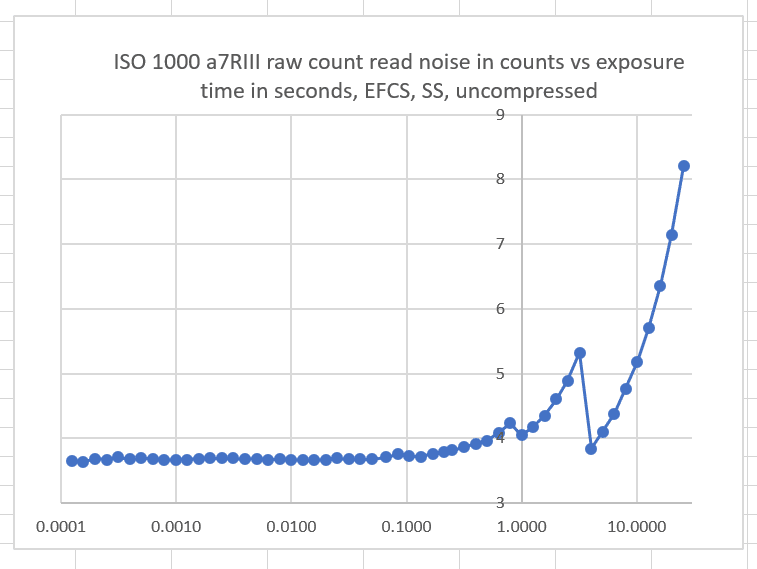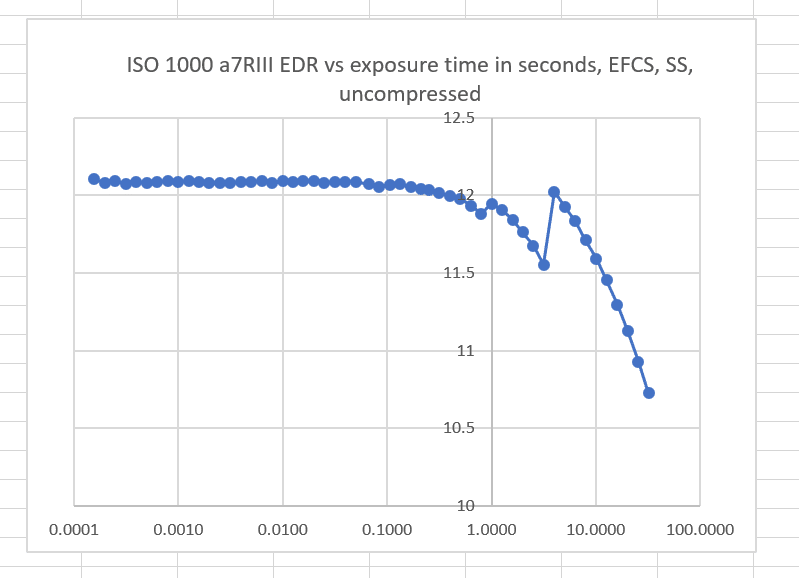This is a continuation of a series of posts on the Sony a7RIII. You should be able to find all the posts about that camera in the Category List on the right sidebar, below the Articles widget. There’s a drop-down menu there that you can use to get to all the posts in this series.
In the previous post, I showed you how the read noise of the Sony a7RIII varies with ISO setting in various shutter and file modes. The read noise also varies with exposure time in ways that are not obvious to those inexperienced with the alpha seven camera line.
Here is how the read noise (RN) varies with exposure time for single shot (SS) shutter mode, electronic first curtain shutter (EFCS), with ISO set to 1000.
The vertical axis is 14-bit counts, also known as data numbers, or raw data.
In the previous post, we looked at the inverse of RN, engineering dynamic range (EDR). Let’s do that for this data:
The reason the EDR, in general, gets worse as the exposure time gets longer is an effect called dark current. The pixels in the sensor are back-biased photodiodes, which ideally have no leakage. But in engineering, things are never ideal, and these components leak. What’s worse is they leak differently at different pixels, so there’s no way to sort out after the exposure what part of the charge left on the photodiode is due to light hitting it, and what part is merely leakage. At fast shutter speeds, the leakage is inconsequential, but as the integration time increases, it becomes something to worry about.
Sony plays some games to disguise the effect of the dark current. The most pronounced occurs at exposures of 4 seconds and longer, and it is caused by a type of median filter known to its detractors as the star-eater filter. If you go to the Category List in the right-hand sidebar and look for a7RIII posts, you’ll see a lot about this effect. In the above plots, it also appears that there is something going on as the shutter speed is changed from 0.8 seconds to 1 second. It doesn’t look nearly as significant as the processing the starts at 4 seconds, but I’ll take a look at it and see what I can find.


Mike C says
Hi Jim. Would you expect the cliff in EDR/RN to be comparable in exposure/steepness across cameras in the same “class” (e.g., Nikon D850 and GFX), or would you expect the a7riii to fare worse than its competitors? (I haven’t seen any star-eater complaints floating around online for the D850 or GFX…) Also, would you expect a similar trend at base ISO (vs. at ISO 1000)? Thanks for your great work!
JimK says
When I tested the D850 for long exposures, I did not see evidence of spatial filtering as with the a7x cameras.
http://blog.kasson.com/d850/nikon-d850-read-noise-vs-shutter-speed/
The Sony spatial filtering that occurs at ISO 1000 also occurs at all ISO settings below that. Above that, too, except that at really high ISOs another kind of spatial filtering kicks in, too.